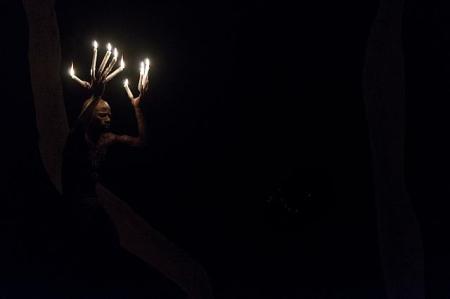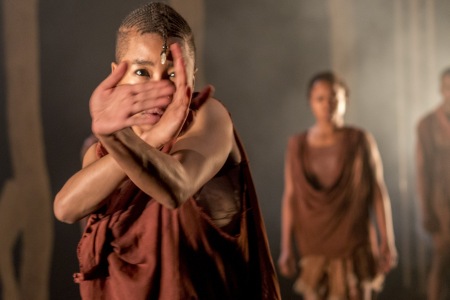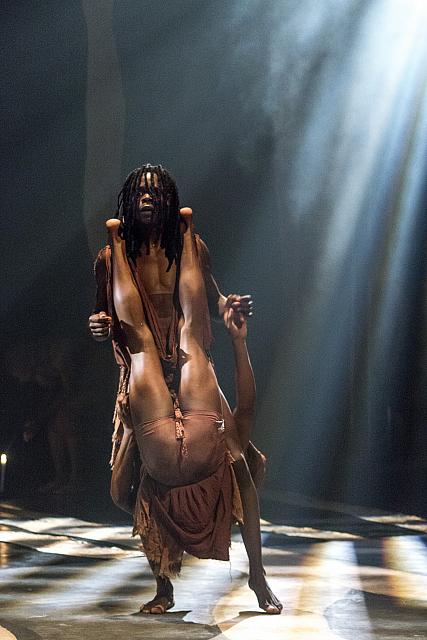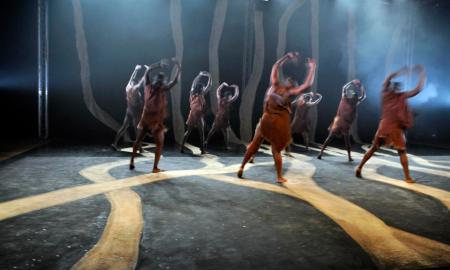The only thing I enjoy more than watching dance, is watching dance with a posse of dancer friends. It was the last night of our performance at the Grahamstown Arts Festival and most of the cast celebrated by going to watch Siva (Seven) choreographed by Luyanda Sidiya, winner of this year’s Standard Bank Young Artist for Dance award and Artistic Director of Vuyani Dance Company. We all felt a bit exhausted, a bit hyped and I was excited to watch a production coming from Vuyani in Johannesburg. Having grown up in Durban and studied in Cape Town, Joburg remains a mysterious city to me and it wouldn’t be entirely inaccurate to admit that I have an art-crush on most choreographers and performing artists who come out of Joburg. After watching this show, my suspicions were confirmed… there must be something in the water in Johannesburg, because Siva (Seven) was unlike any performance I have ever seen in Cape Town or Durban.
The piece begins with a man on stage holding a candle, he moves slowly as the audience walks in. To be honest, I had my doubts about this opening scene and the stage design too. The bold stripes across the stage and the woman bathing herself in a tin bath at the entrance seemed to set the piece up for a bit of a clichéd contemporary dance performance. It hinted at a certain aesthetic we are all rather familiar with but as things progressed, it didn’t take long to be utterly convinced by the sheer commitment of the production to its vision. I promptly forgot my personal aesthetic preferences and became fully absorbed into the world that Luyanda Sidiya and his cast had created.
The man on stage continues moving slowly and intentionally. There is a candle attached to each finger and he starts to light each one, until ten extended digits each have their own flame, bringing briefly to my mind the image of Lumiere in Disney’s Beauty and the Beast. But mostly it reminds me of being a child and dipping the tips of my fingers into the melted candle wax, waiting for it to dry and making tiny white caps, the brief burn somehow totally worth it. It is so satisfying to watch the man do this. I think to myself that even if the rest of the piece is shit, this image is enough. The rest of the piece isn’t shit.

Photo by Niahm Walsh-Vorster.
This candle-lit preset definitely hints at some sort of explosive fire awaiting us and once the full cast takes charge of the stage, the flame continues to grow unabated. The rest of the piece seems a blur. I remember the following: it was very loud and very quiet, the way in which the dancers moved reminded me of the first time I saw a ballerina, completely impossibly overwhelming beautiful. But more so than a ballerina because they were real humans, not ghostly apparitions. I remember spinning, whirling dervish-style dizziness, I remember the preacher-like figure speaking in a language I don’t understand and I remember feeling very white (normal). I remember a woman who did something strange to my insides (in a good way).
I remember at some point the audience was instructed to stand and look under the small cushions that were placed on our seats. There we found a very familiar pamphlet that I’ve seen all over Durban (but not so much in Cape Town?) advertising all the wonderful and extravagant ways in which our lives could be better. The audience chuckles, we’re instructed to sit again. It is a very kind moment wherein the choreographer allows a pause, a moment to stretch our legs and relax our lungs amidst the intensity of the performance. It’s the kind of choreographic gesture that one could  read a lot into but I choose to focus on the dancers and choreography and save some theoretical reflection for after the show. The piece continues to build and the dancers are amazing. My jaw is closer to the ground than it usually is.
read a lot into but I choose to focus on the dancers and choreography and save some theoretical reflection for after the show. The piece continues to build and the dancers are amazing. My jaw is closer to the ground than it usually is.
After the show, we regroup and mostly talk about the dancers and the various ways in which we feel both completely inspired and utterly inadequate. The choreography, the dance movement vocabulary, the overwhelming energy and ability of the dancers overwhelmed us. Conceptually, however the discussion is rather limited. No one really talks about the pamphlet under the seat nor other moments that could have sparked the cerebral unpacking of movement, text and meaning. From what I gathered on the night and from subsequent internet perusings, the piece looks at what it is to be human, ideas of spirituality, the quest for self-knowledge, self-realization, for something divine perhaps? Luyanda’s statement itself is interesting, relevant but somehow evasive:
“As human beings tangled in our own disorder, disruption, and disassociation we constantly yearn for that which guides us to completeness, to oneness. We are in constant search within ourselves, in others, and all around us, for connectedness and peace.” (From Vuyani’s website)
I think to myself that perhaps the piece could have been conceptually more stream-lined but in truth I feel like it is the kind of work that makes you feel instead of think. I usually prefer choreography that makes one both feel and think but in no way do I feel short-changed. This piece commits to itself in such a brave and beautiful manner that I walk away not only feeling pleased but also proud that South Africa is producing such unique and high-quality choreographic work.
A bit later we descend on the cast at the Long Table and fan-girl them in a deeply unprofessional fashion. Luyanda Sidiya is unassuming and friendly, he seems thoughtful, kind and genuinely pleased that we enjoyed the show (a lot). Generally, successful choreographers in this country end up in Europe and I am saddened at the thought that perhaps one day an artist like this will be operating mostly in the Northern Hemisphere where money seems to actually like art. I both hope and don’t hope this is the case as I want to keep his work here, where South Africans can see it. However if a certain South African dance aesthetic (whatever the hell that is) does have to be exported and displayed on the international (read European) stage, then I really hope it’s a work like Siva (Seven). If you want to read more about the work and listen to an interesting discussion with Luyanda Sidiya, check out this post at Archetype Online Magazine.


